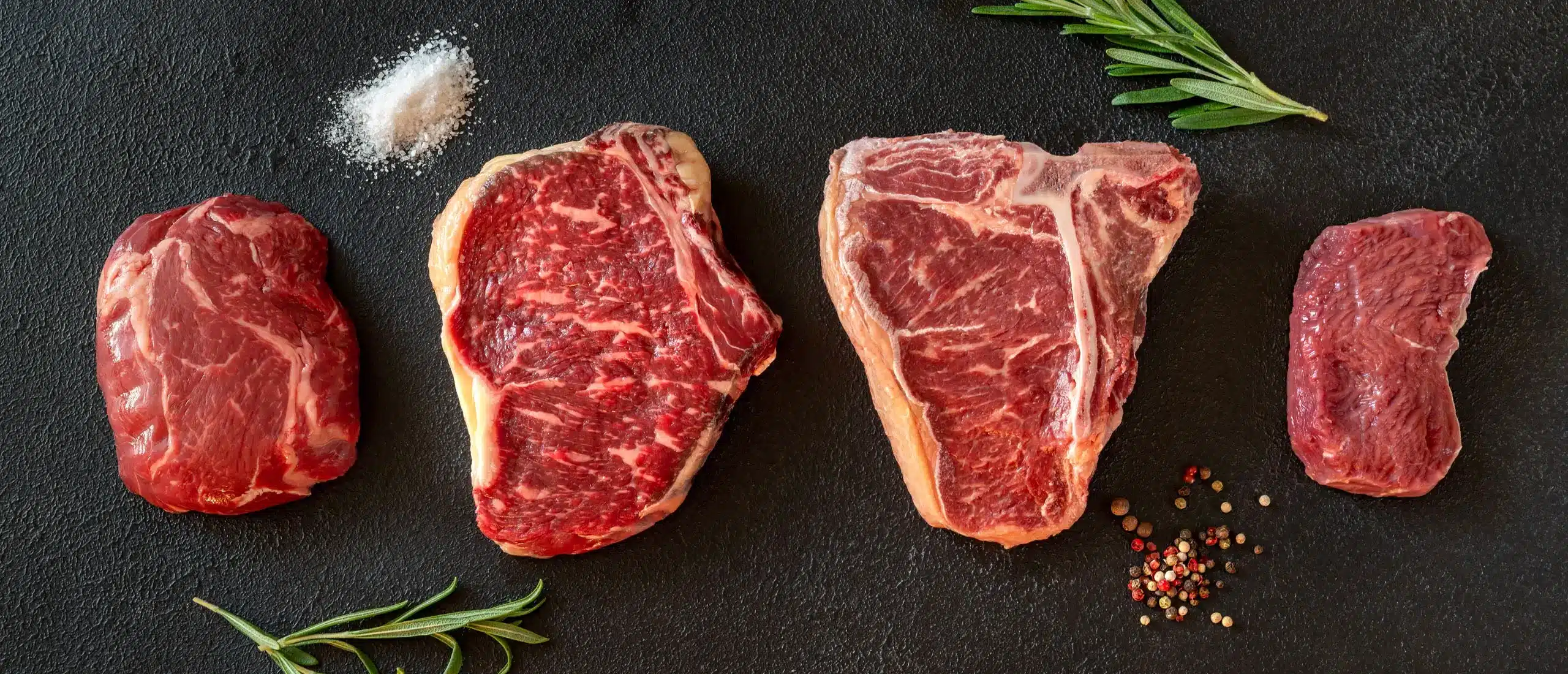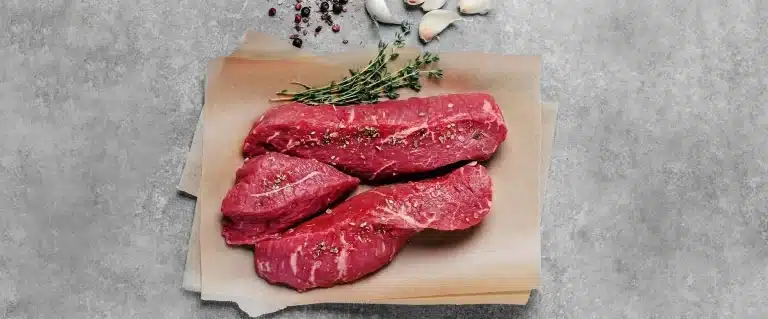Ranking the Leanest (and Fattiest) Cuts of Steaks
What’s better than sinking your teeth into a perfectly bloody steak? Recent research is telling you to have another.
If there is a health risk from eating beef and pork, it’s small, according to a study published in Nature Medicine (1). Red meat is packed with protein, which is critical for muscle growth and recovery (2). It also contains key nutrients like iron which is essential for growth and tissue repair, and vitamin B12 to keep you energized.
An American butcher makes an average of 17 different cuts of beef from a single cow. Each has its own flavor profile, texture, taste, and nutritional breakdown. Most Americans tend to value marbling—the level of intramuscular fat in the meat. The more marbled a cut is, the more flavor and tenderness you can expect.
If you’re watching what you eat, save marbled cuts like the porterhouse and prime rib for special occasions. They’re packed with the most calories, fat, and saturated fat—which can increase LDL (the bad kind) cholesterol (3).
What are the leanest cuts of steak? Here, popular cuts of beef, ranked from leanest to fattiest, below.
The Leanest Cuts of Steak, Ranked
These lean cuts of steak are perfect for weeknights when you’re looking to stay on the straight and narrow. Exactly how they compare in calories, total fat, saturated fat, and protein is listed below. Plus, we dig into how to prepare them to maximize flavor and texture.
| Per 8 oz Portion Size | Calories | Total Fat | Saturated Fat | Protein |
| 363 | 10 grams | 3.9 grams | 66.9 grams | |
| 382 | 9.8 grams | 4.3 grams | 68.6 grams | |
| 405 | 16 grams | 5.7 grams | 62.9 grams | |
| 439 | 18.7 grams | 7.8 grams | 63.3 grams | |
| 482 | 20.3 grams | 8 grams | 69.7 grams |
1. Eye of Round Steak
The eye of round—also known as round eye pot roast—is a cut of beef that comes from the round (hind leg) of a cow. It resembles a tenderloin but is way tougher and less juicy. It takes marinades well and is great for slow cooking or roasting. Try it in a pot roast.
Fun fact: eye of round is also often used for roast beef at the deli, but we’d recommend staying away from it in that form. Deli meat is packed with nitrates, which have been linked to cancer (4). Sorry, French dip lovers.
2. Top Round Steak
Sometimes referred to as a London broil or family steak, the top round steak is known for being more flavorful and tender than other cuts from the round. It’s also easy on the wallet, making it a good choice for gatherings or a feast for one. This thick and versatile weekday cut is typically broiled or slow-cooked to bring out its best, like this slow-roasted beef.
3. Sirloin Tip Center Steak
The sirloin tip center steak is a good value for one of the most tender cuts of beef. Marinate it first to improve tenderness and flavor. It’s best cooked quickly— either grilled or pan-fried.
4. Flank Steak
The flank steak is ranked one of the best lean cuts for taste and tenderness. This boneless cut comes from a cow’s torso. Flank steaks take very well to marinades, and are best grilled or stir-fried—like this grilled flank steak with salsa verde. Pro tip: after cooking, cut it against the grain for best tenderness.
5. Tenderloin Steak
If you’re looking for a lean cut that is buttery and mild, you want a tenderloin steak. This is also known as filet mignon, beef tenderloin, and chȃteaubriand—the filet mignon lies on the thinner end of the loin, while the chȃteaubriand the thicker. It’s great grilled, or pan-seared and finished in the oven.
The Fattiest Cuts of Steak, Ranked
Is your favorite steak below? Womp, womp. Sorry, bub. Sadly, when the USDA evaluated these cuts, they trimmed the fat to 1/8th to zero inches. Meaning your go-to steak is probably worse than what you see below. The good news: they can still be enjoyed in moderation, just watch the portions, which tend to be on the larger side.
| Per 12 oz Portion Size | Calories | Total Fat | Saturated Fat | Protein |
| 477 | 18.2 grams | 15.4 grams | 77.8 grams | |
| 727 | 39.1 grams | 16.1 grams | 93.6 grams | |
| 802 | 43.6 grams | 16.8 grams | 96 grams |
1. Porterhouse and T-Bone Steak
With a porterhouse or T-bone you get flavor, flavor, and more flavor. The porterhouse comes from the cross-section of the short loin with a filet and a NY strip separated by a bone. A T-bone is a cut below the porterhouse. According to the USDA, the tenderloin portion must be 1.25 inches wide to be classified as a porterhouse and only .5 inches wide to qualify as a T-bone. Unlike a NY strip, the T-bone and porterhouse leave the bone in, which yields an overall juicier steak.
2. Ribeye Steak
The ribeye is a very marbled cut—which is why it’s most prized by steak enthusiasts. It comes from the rib roast or prime rib. A ribeye’s fat content gives the meat flavor and ensures it stays tender while cooking. Whether it’s cooked on the grill or reverse-seared, you can’t go wrong.

Want exclusive content? Our digests do that.
The best science-backed, expert-driven health and lifestyle content delivered to your inbox, weekly.
How to Choose the Leanest Cuts of Steak
You can evaluate any steak at the grocery store by checking the label, which is subject to government regulation. The USDA regulates whether cuts of beef can be labeled as “lean” or “extra lean” based on their fat and cholesterol content.
Lean Cuts of Steak
The USDA defines a lean cut of beef as a 3.5 ounce (100 grams) serving that contains less than:
- 10 grams of total fat
- 4.5 grams of saturated fat
- 95 milligrams of cholesterol
Extra-Lean Cuts of Steak
They define an extra lean cut of beef as a 3.5 ounce (100 grams) serving that contains less than:
- 5 grams of total fat
- 2 grams saturated fat
- 95 milligrams of cholesterol
Keep in mind, beef might also be graded “Prime”, “Choice”, or “Select”—a voluntary program manufacturers use to judge the perceived quality of the meat. In general, opt for “Choice” or “Select” cuts which typically have less fat. Unless you’re celebrating something special, then hey, go for the “Prime”.
References
1. Lecinsky, H. et al (2022). Health Effects Associated With Consumption of Unprocessed Red Meat: A Burden of Proof Study. https://www.healthdata.org/research-article/health-effects-associated-consumption-unprocessed-red-meat-burden-proof-study
2. Carbone, J. et al (2019). Dietary Protein and Muscle Mass: Translating Science to Application and Health Benefit. https://www.ncbi.nlm.nih.gov/pmc/articles/PMC6566799/
3. Saturated Fatty Acids and Risk of Coronary Heart Disease: Modulation by Replaced Nutrients. https://www.ncbi.nlm.nih.gov/pmc/articles/PMC2943062/
4. Nitrates/Nitrites in Food—Risk for Nitrosative Stress and Benefits. https://www.ncbi.nlm.nih.gov/pmc/articles/PMC7139399/












